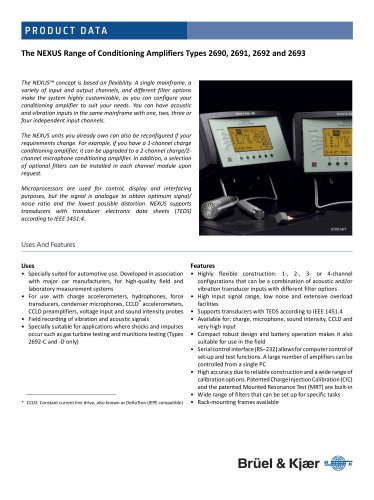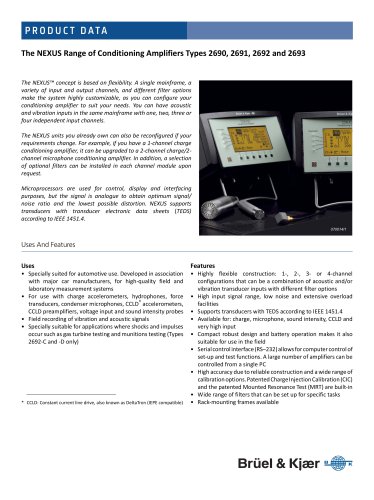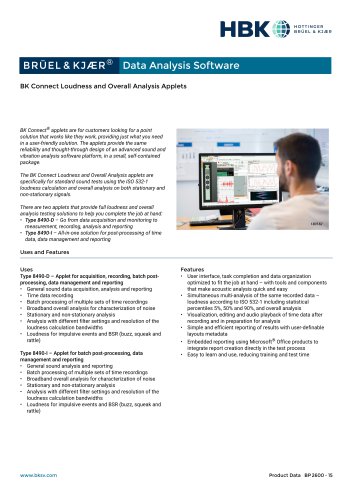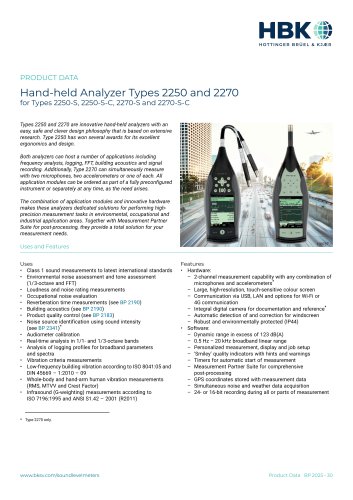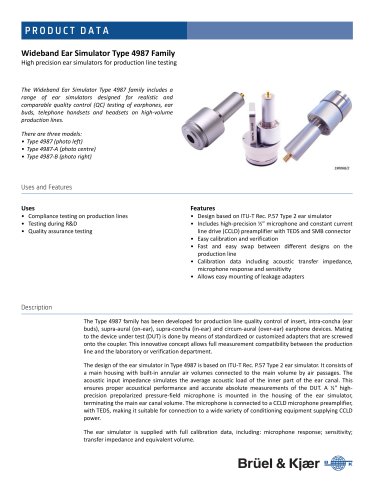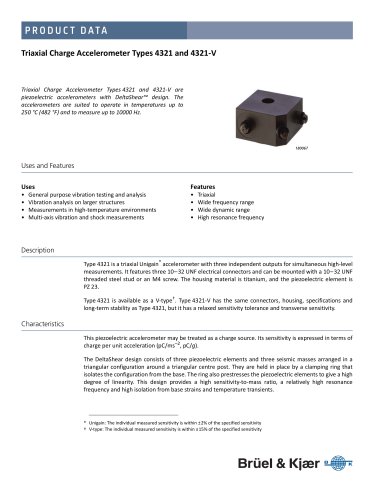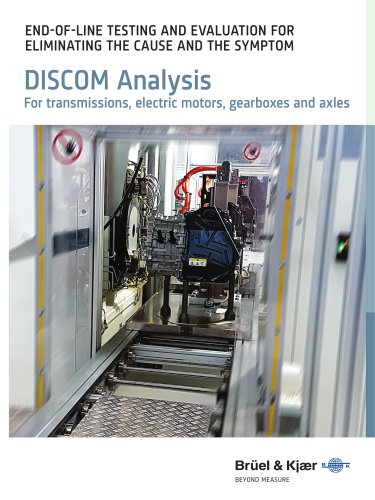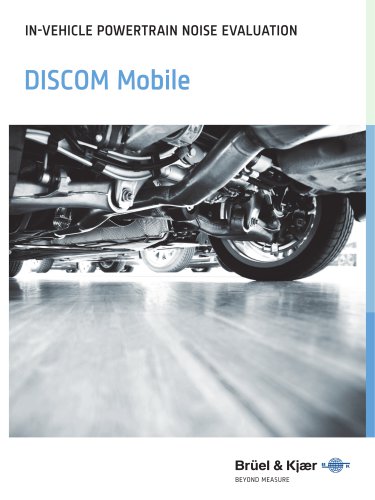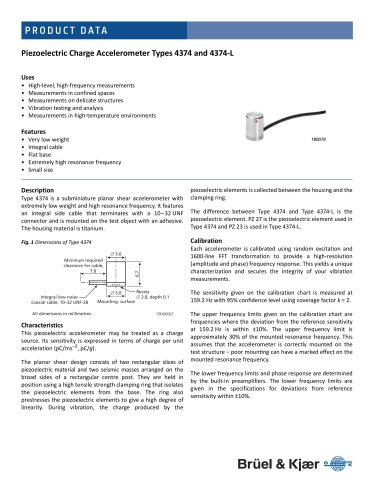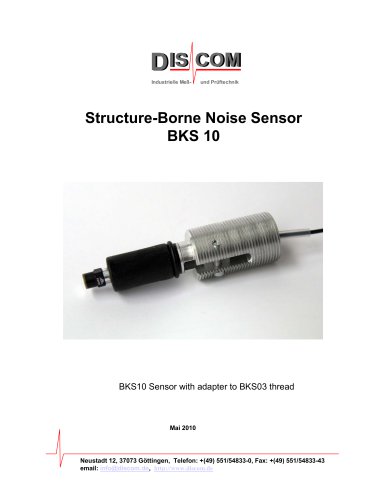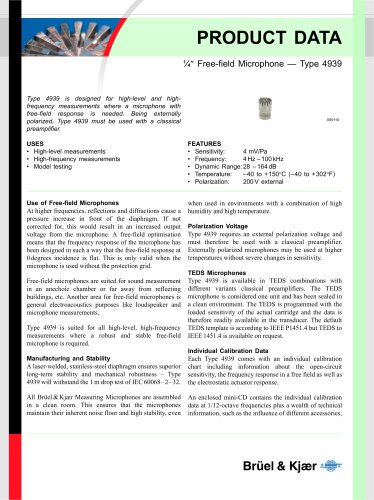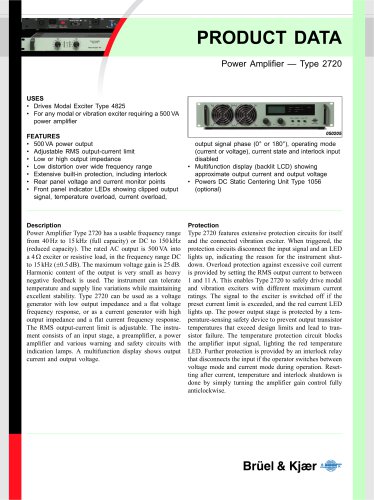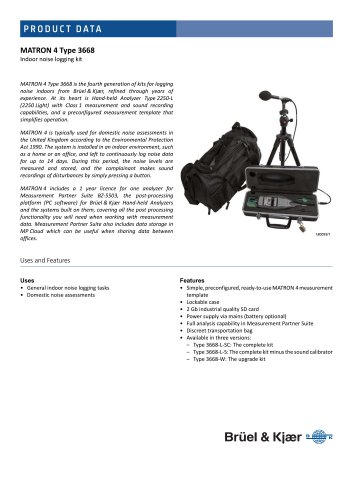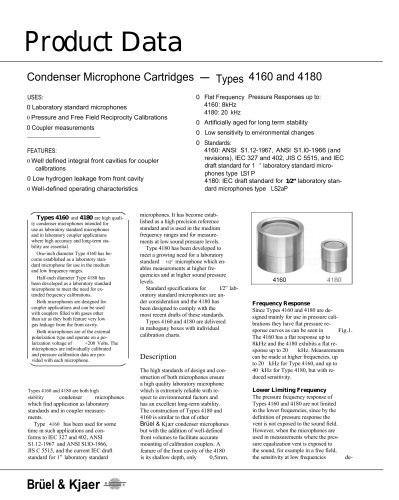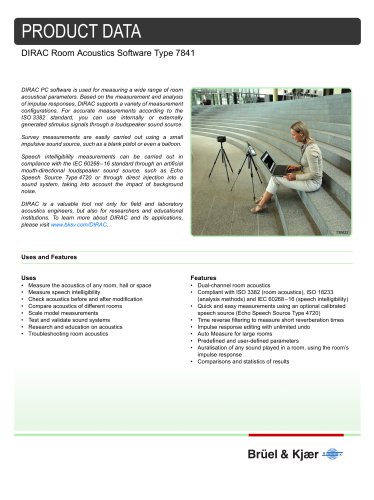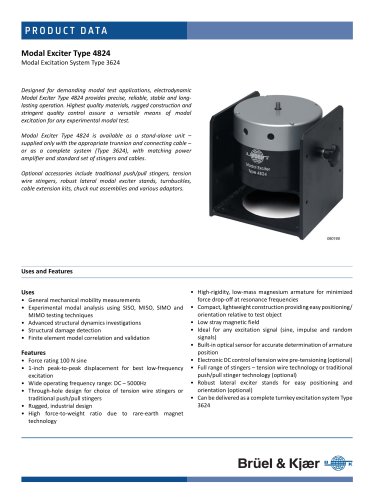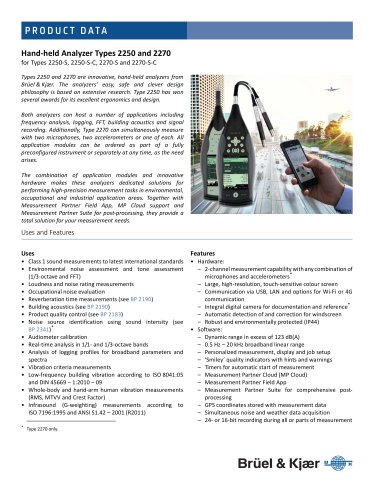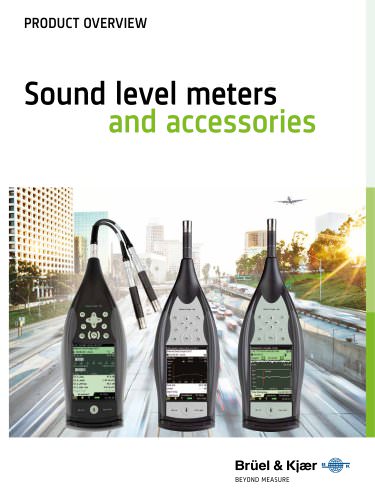
Catalog excerpts

P R O D U C T D ATA The NEXUS Range of Conditioning Amplifiers Types 2690, 2691, 2692 and 2693 The NEXUS™ concept is based on flexibility. A single mainframe, a variety of input and output channels, and different filter options make the system highly customizable, as you can configure your conditioning amplifier to suit your needs. You can have acoustic and vibration inputs in the same mainframe with one, two, three or four independent input channels. The NEXUS units you already own can also be reconfigured if your requirements change. For example, if you have a 1-channel charge conditioning amplifier, it can be upgraded to a 2-channel charge/2channel microphone conditioning amplifier. In addition, a selection of optional filters can be installed in each channel module upon request. Microprocessors are used for control, display and interfacing purposes, but the signal is analogue to obtain optimum signal/ noise ratio and the lowest possible distortion. NEXUS supports transducers with transducer electronic data sheets (TEDS) according to IEEE 1451.4. Uses And Features Uses • Specially suited for automotive use. Developed in association with major car manufacturers, for high-quality field and laboratory measurement systems • For use with charge accelerometers, hydrophones, force transducers, condenser microphones, CCLD* accelerometers, CCLD preamplifiers, voltage input and sound intensity probes • Field recording of vibration and acoustic signals • Specially suitable for applications where shocks and impulses occur such as gas turbine testing and munitions testing (Types 2692-C and -D only) • Highly flexible construction: 1-, 2-, 3- or 4-channel configurations that can be a combination of acoustic and/or vibration transducer inputs with different filter options • High input signal range, low noise and extensive overload facilities • Supports transducers with TEDS according to IEEE 1451.4 • Available for: charge, microphone, sound intensity, CCLD and very high input • Compact robust design and battery operation makes it also suitable for use in the field • Serial control interface (RS–232) allows for computer control of set-up and test functions. A large number of amplifiers can be controlled from a single PC • High accuracy due to reliable construction and a wide range of calibration options. Patented Charge Injection Calibration (CIC) and the patented Mounted Resonance Test (MRT) are built-in • Wide range of filters that can be set up for specific tasks • Rack-mounting frames available * CCLD: Constant current line drive, also known as
Open the catalog to page 1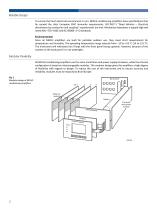
Reliable Design To survive the harsh electrical environment in cars, NEXUS conditioning amplifiers have specifications that far exceed the strict European EMC immunity requirements. ISO 7637-1 “Road Vehicles – Electrical disturbance by conduction and coupling” requirements are met. Mechanical robustness is equally high and meets MIL–STD–810C and IEC 60068–2–6 standards. Environmental Since all NEXUS amplifiers are built for portable outdoor use, they meet strict requirements for temperature and humidity. The operating temperature range extends from –10 to +55 °C (14 to 131 °F). The...
Open the catalog to page 2
Standard Versions A number of standard versions are available that cover the most commonly used configurations. However, if you require a combination not found below, we can provide a custom-made version. NEXUS Standard Version Type/Order Number 2-channel Microphone Conditioning Amplifier with A, B, C and D Filters 4-channel Microphone Conditioning Amplifier with A, B, C and D Filters 1-channel Microphone Conditioning Amplifier 2-channel Microphone Conditioning Amplifier 4-channel Microphone Conditioning Amplifier 2-channel (Single Probe) Intensity Conditioning Amplifier 1-channel Charge...
Open the catalog to page 3
Channel Description A conditioning amplifier can contain up to four modular channels. Each channel consists of a common module, an input module, an optional module and an output module. The common module contains filters, gain settings and calibration functions. The input and output modules have additional gain settings and include high-pass filters. Fig. 2 Back panel of a 4channel NEXUS Conditioning Amplifier Type 2690-A-OS4. Each input module has a 7-pin LEMO connector for connecting Brüel & Kjær’s Falcon range microphones and a BNC output channel Charge Channel A conditioning amplifier...
Open the catalog to page 4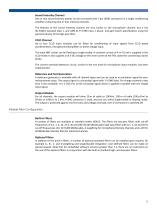
Sound Intensity Channel One or two sound intensity probes can be connected with 7-pin LEMO connectors in a single conditioning amplifier containing two or four intensity channels. The features of the sound intensity channel are very similar to the microphone channel, but it has IEC 61043 standard Class 1 and ANSI S1.9–1996 Class 1 phase- and gain-match specifications using the special intensity 20 Hz high-pass filter. CCLD Channel Up to four CCLD input modules can be fitted for conditioning of input signals from CCLD based accelerometers, microphone preamplifiers or direct voltage input....
Open the catalog to page 5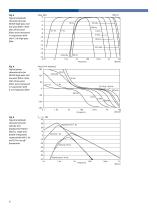
Fig. 3 Typical amplitude characteristics for NEXUS high-pass and low-pass filters. Note that all low-pass filters were measured in conjunction with the 0.1 Hz high-pass filter Fig. 4 Typical phase characteristics for NEXUS high-pass and low-pass filters. Note that all low-pass filters were measured in conjunction with 0.1 Hz high-pass filter Phase Shift (degrees) 180 10 Hz Intensity Fig. 5 Typical amplitude characteristics for velocity and displacement filters (that is, single and double integration, respectively) with 1 Hz and 10 Hz cut-off frequencies
Open the catalog to page 6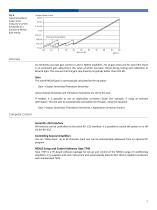
Fig. 6 Typical broadband output noise measured in 22 kHz bandwidth as a function of NEXUS gain setting Output Noise (Vrms) 30mV 10 mV 3.16 mV 1 mV 316 μV CCLD and Preamplifier 100 μV 31.6 μV 10 μV –20 Accuracy An extremely accurate gain control is used in NEXUS amplifiers. For all gain steps and for each filter there is an automatic gain adjustment, the value of which has been stored during testing and calibration at Brüel & Kjær. This ensures that the gain step linearity is typically better than 0.02 dB. Gain The overall NEXUS gain is automatically calculated by the equation: Gain = Output...
Open the catalog to page 7All Bruel and Kjaer catalogs and technical brochures
-
Data Analysis Software
6 Pages
-
B&K 2245 Sound Level Meter
8 Pages
-
HBK 2255 Sound Level Meter
10 Pages
-
Artificial Mastoid Type 4930
6 Pages
-
Power Amplifier Type 2718
2 Pages
-
DISCOM Mobile
6 Pages
-
DISCOM NVH Analysis Systems
4 Pages
-
TEDS Microphones
8 Pages
-
LDS V8
4 Pages
-
LDS Comet USB
4 Pages
-
LDS Laser USB
16 Pages
-
4374
2 Pages
-
4326-A-001
8 Pages
-
4152
4 Pages
-
4191
2 Pages
-
2719
2 Pages
-
LDS V8900
4 Pages
-
BKS 10
8 Pages
-
1704-A-001
4 Pages
-
4939
2 Pages
-
4138
4 Pages
-
4101-B and 4965-B
4 Pages
-
Sonoscout NVH Recorder
8 Pages
-
LDS Power Amplifiers
8 Pages
-
Type 2720
2 Pages
-
Type 2721
2 Pages
-
TYPE 3668
4 Pages
-
3656-A
4 Pages
-
TYPE 2270-S
28 Pages
-
LDS V994
2 Pages
-
TYPE 8702
16 Pages
-
BZ-7848-A
40 Pages
-
TYPE 9718-A:bp0317
12 Pages
-
TYPE 4720:bp1974
12 Pages
-
TYPE 4824:bp1936
4 Pages
-
SOUND LEVEL METER:bp 2025
28 Pages
-
Transducers and conditioning
188 Pages
-
Noise Sentinel Overview
3 Pages
-
Analyzer Catalogue
39 Pages
-
Noise Logger Type 3659
1 Pages
-
Sound level meters
17 Pages

